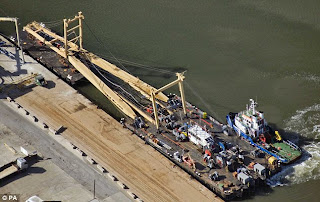Friday, May 03 20133PM 48°F6PM50°F5-Day Forecast
Last surviving Second World War Dornier bomber is to be raised from its watery grave after 70 years in biggest recovery of its kind
- German bomber has lain in English Channel since the Battle of Britain
- £350,000 project to retrieve the plane and display it at the RAF Museum
By Hugo Gye
PUBLISHED:04:56 EST, 3 May 2013| UPDATED:08:07 EST, 3 May 2013
A rare German bomber from the Second World War is set to be raised from the English Channel where it has lain for seven decades, it was announced today.
The retrieval of the last surviving Dornier Do 17 from the Goodwin Sands off the coast of Kent will be the biggest recovery of its kind in British waters.
The aircraft was first spotted by divers in 2008, lying 50ft below the surface on a chalk bed, surrounded by debris.

Under the sea: A Dornier Do 17 bomber which lies off the coast of Kent is set to be recovered
Sonar scans carried out by the RAF Museum, Wessex Archaeology and the Port of London Authority confirmed that the plane is the Dornier Do 17Z Werke number 1160, which was shot down during the Battle of Britain.
Two of its four-man crew were killed as it crashed into the sea, but the other two were captured and taken into custody as prisoners of war.
The plane, which is said to be in 'remarkable condition', was one of the Luftwaffe's 'flying pencil' bombers, named for their narrow fuselage.
It is covered in coral, barnacles and other marine life, but is otherwise largely intact.
The main undercarriage tyres remain inflated and the propellers clearly show the damage inflicted during the bomber's final crash landing.
Lifting the plane from the sea will take around three weeks using pioneering technology, and will be dependent on tides and weather conditions.

Mission: Recovery workers prepare the mechanism which will help to retrieve the German plane from the Channel

Unprecedented: This will be the biggest operation of its kind ever to take place in British waters
GERMANY'S 'FLYING PENCIL' PLANE
The Dornier Do 17 was known as the 'flying pencil', because of its unusually narrow fuselage.
It was one of the main bombers used by the Luftwaffe during the Second World War, including at the Battle of Britain in 1940.
The plane was developed to be a commercial aircraft, but was turned down by Lufthansa and redesigned into a bomber.
Although the Do 17 was no longer made after 1940, it was used by Nazi forces throughout the war.
More than 400 of them were flown in the Battle of Britain, with 171 shot down by the RAF or otherwise lost.
The planes were 52ft long with a wingspan of 59ft, and could carry 2,000lb of explosives while manned by a crew of four.
None of the aircraft were believed to have survived for long after the end of the conflict, until the discovery of the plane off the coast of Kent.
A frame will be built around the aircraft underwater, and will then be slowly winched up and placed on a floating platform.
The operation has been made possible by a grant of more than £345,000 from the National Heritage Memorial Fund.
Air Vice-Marshal Peter Dye, director general of the RAF Museum, said: 'The discovery and recovery of the Dornier is of national and international importance.
'The aircraft is a unique and unprecedented survivor from the Battle of Britain and the Blitz.
'It will provide an evocative and moving exhibit that will allow the museum to present the wider story of the Battle of Britain and highlight the sacrifices made by the young men of both air forces and from many nations.'
When the Dornier has been recovered, it will be prepared for display at the RAF Museum in Hendon, North London.
The preservation work will take place at the museum's conservation centre in Cosford, Shropshire, where the plane will be placed in two hydration tunnels and soaked in citric acid.
Underwater footage of Dornier 17 survey by the RAF Museum


Channel: The plane was sunk in Goodwin Sands, off the coast of Kent near Deal

In action: A Dornier bomber similar to the one which crashed into the sea during the Battle of Britain
Culture minister Ed Vaizey said: 'Today marks the beginning of an exciting project to raise the last surviving Dornier Do 17 bomber from the English Channel.
'I'm delighted the RAF Museum and the NHMF have joined forces to make this project possible and I know that it will be a tremendous addition to the museum's collection where it will serve to educate and entertain all who visit.'
The Dornier Do 17 will join a range of more than 1,200 objects and places which have been safeguarded by the NHMF at a cost of more than £300million.
These include HMS Caroline, the last surviving First World War ship, a rare collection of work by codebreaker Alan Turing and HMS Alliance, the last surviving submarine of the Second World War.
The Dornier is not the only Second World War plane to be the subject of a recovery mission - a British enthusiast is currently searching for a haul of Spitfires lost in the Burmese jungle.
David Cundall has hired a team of workers to find the 36 fighters which he says were delivered to the country at the very end of the war.













No comments:
Post a Comment